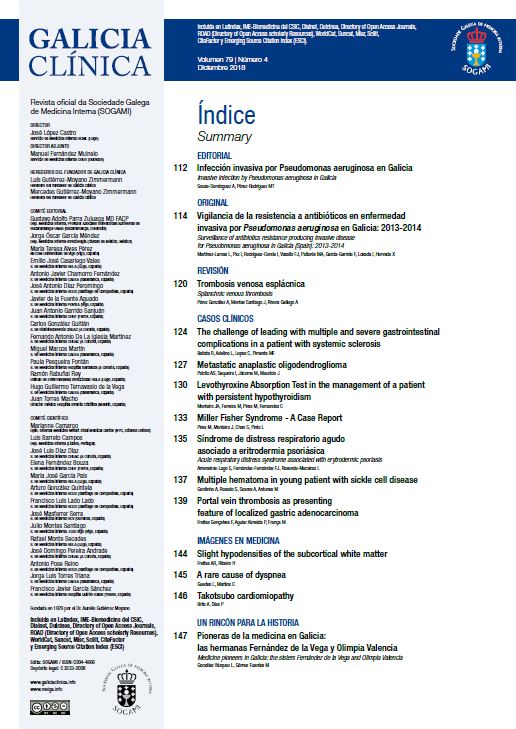Abstract
Introducción. El objetivo de este estudio es conocer la sensibilidad antibiótica de Pseudomonas aeruginosa productora de enfermedad invasiva en Galicia en 2013/2014, en el marco del Estudio de Vigilancia de las Resistencias Antimicrobianas.
Métodos. Se analizaron 357 aislamientos de P. aeruginosa en muestras de sangre o LCR en 9 hospitales de Galicia. Las variables fueron: procedencia, datos demográficos, tipo de muestra y sensibilidad antibiótica. Se usaron puntos de corte de CLSI. Para cada antibiótico se analizaron frecuencias, casos/100.000 habitantes, concordancia de la resistencia y diferencias entre hospitales, sexo y edad.
Resultados. El sexo predominante fue el masculino y la no sensibilidad superior en el grupo de 45 a 64 años con diferencias significativas a ciprofloxacino, imipenem, tobramicina y colistina. La no sensibilidad global: piperacilina/tazobactam 18%, ciprofloxacino 28'7%, ceftazidima 17'1%, cefepime 19'7%, imipenem 23'1%, meropenem 22'1%, tobramicina 13'0%; amikacina, 7'3% y colistina 4'4%. Los casos/100.000 habitantes fueron superiores en hombres según aumenta la edad. Sin analizar la colistina, el 57'1% de los aislamientos fueron sensibles a los otros grupos estudiados (piperacilina/tazobactam, quinolonas, ceftazidima, aminoglucósidos, carbapenems), el 19'4% fueron no sensibles a un antibiótico, 12'2% a dos, el 3'7% a tres, el 5'1% a cuatro y el 2'0% a todos los analizados.
Conclusiones. De los antibióticos evaluados, los más activos frente a P. aeruginosa fueron amikacina y colistina. Nuestros datos concuerdan con lo observado a nivel nacional, excepto para colistina. Deben evaluarse periódicamente patrones de sensibilidad de P. aeruginosa en cada zona y cada hospital para poder valorar las diferentes pautas terapéuticas.
SUMMARY
Introduction. The aim of this study is to understand the nature of the Pseudomonas aeruginosa antibiotic sensitivity, producer of invasive infections in Galicia in 2013/2014., within the framework of the Study of Surveillance of Antimicrobial Resistance.
Methods. A total of 357 isolates of P. aeruginosa were studied in blood or CSF samples from 9 hospitals in Galicia. The variables were: origin, demographic data, type os sample and antibiotic sensitivity. CLSI sensitivity breakpoints were used. Frecuencies, rates/100.000 inhabitants, concordance of resistance and differences between hospitals, sex and age were calculated for each antibiotic.
Results. The majority of patients were male and the not-sensitives was superior in the age group 45 to 64 with significant differences to ciprofloxacin, imipenem, tobramycin and colistin. The overall not-sensitive isolates was: piperacillin/tazobactam 18%, ciprofloxacin 28.7%, ceftazidime 17.1%, cefepime 19.7%, imipenem 23.1%, meropenem 22.1%, tobramycin 13.0%, amikacin 7.3% and colistin 4.4%. Rates per100,000 population are higher in men and with increasing age. Without analyzing colistin, the 57.1% of the isolates were sensitives to other antibiotics studied (piperacillin/tazobactam, quinolone, ceftazidime, aminoglycosides, carbapenems), 19.4% were not-susceptible to only one antibiotic, 12. 2% to two, 3.7% to three, 5.1% to four and 2.0% to all antibiotics tested.
Conclusions. Of the antibiotics tested, the most susceptible to P. aeruginosa were amikacin and colistin. Our data are consistent with the observed ones nationwide except colistin. Sensitivity patterns of P. aeruginosa should be evaluated in each area and hospital and also periodically to be able to evaluate the differents treatment regimens.
© 2018 Galicia Clínica.
Complete article | Pdf article


